Task Analysis of Intersection Driving Scenarios: Information Processing Bottlenecks
PDF files can be viewed with the Acrobat® Reader®
Scenario 2–Left Turn on Yellow Light
Description
This scenario involves a vehicle making a left turn on a yellow light. Figure 13 shows the scenario diagram and provides additional details regarding the scenario. Briefly described, this scenario involves the subject driver identifying the intersection as the turn location, then decelerating. As the decelerating subject vehicle nears the intersection, the traffic light turns yellow. With no leading traffic and with the subject vehicle close enough to the intersection to go, the vehicle enters the intersection after determining that it is safe to do so and proceeds with the turn. The alternative scenario in which the traffic signal turns yellow while the driver is established in the intersection and waiting for a gap in traffic is probably more common because drivers spend more time in this phase; however, this situation was not investigated because it is nearly identical to Scenario 1 with the exception that the onset of the yellow light simplifies the task by stopping oncoming traffic.
This scenario was divided into five segments (Approach, Deceleration, Decision to Proceed, Intersection Entry, and Execute Turn). The primary bases for parsing the scenario into these particular segments were that each segment had a different overall driving goal and most segments had different speed characteristics (table 17).
Table 17. Scenario 2–Left Turn on Yellow Light driving objectives and
speed characteristics as basis for each scenario segment partitioning.
|
Segment
|
Driving Objectives
|
Speed Characteristics
|
|
Approach
|
Identify upcoming intersection as the location of the turn.
|
Traveling at full speed.
|
|
Deceleration
|
Slow to turning speed/stop.
|
Controlled deceleration.
|
|
Decision to Proceed
|
Determine if there is sufficient time to turn and whether it is safe to do so.
|
Traveling at reduced speed, possibly decelerating.
|
|
Intersection entry
|
Get into position to turn.
|
Traveling at a slow speed, possibly decelerating.
|
|
Execute turn
|
Make the turn.
|
Turning and accelerating up to speed.
|
The crash data associated with this scenario are basically the same as in Scenario 1 (Left Turn on Green Light). In particular, the most common type of crash (involving 76 percent of crashes) in this scenario involves turning vehicles being struck by an oncoming vehicle,(20) which suggests that the activities preceding the turn (Intersection Entry Segment in this scenario) are the most challenging for drivers. The most common causal crash factors (in order of prevalence) include misjudging the gap, looking but not seeing oncoming traffic, view obstructed by intervening vehicles, and other vehicle violations.(20, 21) If only incidents in which the subject vehicle remains in motion before turning are considered (same as the current scenario), then the primary causal factors are misjudging the gap, looking but not seeing oncoming traffic, and violation of signal by the principle other vehicle (POV).(20) One point worth noting is that in more than two-thirds of the recorded cases, the subject vehicle was in motion before turning (rather than stopping first), which likely reflects the fact that less time is available to make judgments about whether or not it is safe to turn. Figure 13 shows the scenario diagram and details.
|
Scenario 2 Diagram

- Segments are demarked by dotted lines.
- Approximate speed in km/h is indicated on the right.
Note: Illustration dimensions and vehicle positions are not to scale.
Figure 13. Scenario 2–Left Turn on Yellow Light diagram, details, and assumptions.
|
Scenario Details
Activity:
Left Turn on a Yellow Light
Scenario Segments:
- Approach
- Deceleration
- Decision to proceed
- Intersection entry
- Execute turn
Intersection Configuration:
Four-lane urban signalized intersection without a dedicated left-turn lane or a left-turn signal.
Traffic Volume:
Moderate (driving speeds are at speed limit and other lead/following/adjacent vehicles are present).
Assumptions/Complicating Factors:
- There is no dedicated left-turn lane or turn signal.
- The subject vehicle is not following any vehicles, but is being followed by another vehicle.
- The turn intersection is familiar to the subject vehicle driver.
- The signal turns yellow while the driver is just past the dilemma zone.
- There is oncoming traffic that decelerates rapidly to a stop once the light turns yellow.
- No lane change is required to get into the turning lane.
- Visibility of oncoming traffic is not blocked by intervening vehicles.
|
Several assumptions were made regarding the situational aspects of the scenario. The justifications for these are summarized in figure 13 and more fully described in table 18.
Table 18. Scenario 2–Left Turn on Yellow Light assumptions and corresponding justifications.
|
Assumption
|
Justification
|
|
There is no dedicated left-turn lane or turn signal.
|
Not including these items makes the task more difficult.
|
|
The subject vehicle is not following any vehicles but is being followed by another vehicle.
|
A lead vehicle was not included because it allows the left turn to be taken without the subject vehicle first coming to a stop. This situation also limits the time available to determine if it is safe to turn.
|
|
The turn intersection is familiar to the subject vehicle driver.
|
The driver merely has to recognize the intersection as the correct turn intersection, which provides some variation from other scenarios.
|
|
The signal turns yellow while the driver is just past the dilemma zone.
|
This situation increases the difficulty of the decision stage, while making it necessary to proceed with the turn.
|
|
There is oncoming traffic that decelerates rapidly to a stop once the light turns yellow.
|
This situation increases the difficulty of judging the safety of the turn, but still allows the turn to be made without stopping.
|
|
No lane change is required to get into the turning lane.
|
Although lane changes are common in turning situations, lane changes were left out to simplify segmentation.
|
|
Visibility of oncoming traffic is not blocked by intervening vehicles.
|
This element was not included because other research suggests that driver responses to this situation are complex and vary widely in ways that are impractical to model.(22)
|
Scenario Timeline
An approximate timeline showing the key temporal milestones for Scenario 2 was calculated based on vehicle kinematics (figure 14). These milestones were used to make judgments about the pacing of tasks within segments, in addition to providing a basis for the overall sequencing of certain tasks. Some segments included an interval with a variable time component, which represented intervals that were either long enough to effectively provide unlimited time to perform tasks or of a duration that was determined external to vehicle kinematic factors (e.g., waiting for lead vehicle to turn).

Figure 14. Scenario 2–Left Turn on Yellow Light
timeline depicting key segment phases duration and event/task milestones.
Note that the yellow light onset time was arbitrary, but nevertheless important, because it affects the allocation of tasks within segments and the time available to perform some of those tasks. A primary objective in setting the yellow onset time was to have the light change when it was not safe for the subject vehicle to stop (which works out to be just after the braking distance in this scenario). Another consideration was that the light should not change to red until after the turn was initiated (start of Execute Turn segment), so that the subject driver would still be required to check for-and need to be able to stop in response to-oncoming traffic crossing on a late yellow light. Thus, a yellow onset time of 2.5 sec after the start of the Deceleration segment (and exactly 4 sec before the Execute Turn segment) was chosen because it maximizes the time available to perform the tasks that need to be completed before the start of the Execute Turn segment, while still meeting the other requirements.
Task Analysis Table
The results of the task analysis, organized by scenario segment, are shown in the task analysis table for Scenario 2 (table 19). The task analysis results are duplicated for individual segments in the segment analyses tables in the next sections, which also contain additional discussions about the organization and content of the tasks and information processing subtasks.
Table 19. Scenario 2–Left Turn on Yellow Light task analysis table.
|
Task
|
Perceptual Subtasks
|
Cognitive Subtasks
|
Psychomotor Subtasks
|
|
2.1 Approach
|
|
2.1.1. Maintain safe lane position.
|
Visually monitor roadway ahead.
|
Verify correct lane position.
|
Make necessary adjustments to steering.
|
|
2.1.2. Check surround for unsafe situations.
|
Scan for potential obstacles/hazards.
Listen for indications of unsafe situations.
|
Determine whether perceptual input indicates if current situation is safe/unsafe.
|
Head and eye movements for scanning.
|
|
2.1.3. Decelerate.
|
Visually assess distance to intersection.
|
Determine when vehicle is close enough to intersection to begin deceleration.
|
Coast (foot off accelerator) and/or gentle braking.
|
|
2.1.4. Identify intersection as correct turn intersection.
|
View visual scene for indicator landmarks or street signs.
|
Recognize familiar intersection as correct turn intersection.
|
Head and eye movements for scanning.
|
|
2.1.5. Identify intersection characteristics.
|
Visually identify lane configurations, pavement marking and signs, signal location, etc.
|
Determine if any nonroutine actions are required.
|
Head and eye movements for scanning.
|
|
2.1.6. Activate turn signal.
|
Visually assess distance to intersection.
|
Determine if vehicle is close enough to start signaling.
|
Activate turn signal control.
|
|
2.1.7. Observe status of light.
|
Visually observe traffic signal.
|
Identify color/status of traffic light.
|
Head and eye movements to view traffic signal.
|
|
2.1.8. Determine if the light is about to change.
|
Scan visual scene for key cues (e.g., pedestrian signal).
|
Determine if cues suggest that the light will soon change.
|
Head and eye movements for scanning.
|
|
2.2. Deceleration
|
|
2.2.1. Maintain safe lane position.
|
Visually monitor roadway ahead.
|
Verify correct lane position.
|
Make necessary adjustments to steering.
|
|
2.2.2. Check surround for unsafe situations.
|
Scan for potential obstacles/hazards.
Listen for indications of unsafe situations.
|
Determine whether perceptual input indicates if current situation is safe/unsafe.
|
Head and eye movements for scanning.
|
|
2.2.3. Begin deceleration.
|
Visually assess distance to intersection.
|
Determine when vehicle is close enough to intersection to begin deceleration.
|
Coast (foot off accelerator) and/or initiate braking.
|
|
2.2.4. Observe vehicle deceleration trajectory.
|
Visually assess distance to intersection.
|
Determine that deceleration is sufficient for slowing to turning speed at the intersection.
|
Make necessary adjustments to deceleration rate.
|
|
2.2.5. Maintain safe distance from decelerating following vehicle.
|
Visually assess distance and relative speed of following vehicle.
|
Determine if following-vehicle closing trajectory is safe.
|
Reduce deceleration if necessary.
Head and eye movements to observe rearview mirror.
|
|
Note: The light is assumed to turn yellow at this point (before Segment 3).
|
|
2.3. Decision to Proceed
|
|
2.3.1. Maintain safe lane position.
|
Visually observe roadway ahead.
|
Verify correct lane position.
|
Make necessary adjustments to steering.
|
|
2.3.2. Check surround for unsafe situations.
|
Scan for potential obstacles/hazards.
Listen for indications of unsafe situations.
|
Determine whether perceptual input indicates if current situation is safe/unsafe.
|
Head and eye movements for scanning.
|
|
2.3.3. Observe vehicle deceleration trajectory.
|
Visually assess distance to intersection.
|
Determine that deceleration is sufficient for slowing to turning speed at the intersection.
|
Make necessary adjustments to deceleration rate.
|
|
2.3.4. Maintain safe distance from decelerating following vehicle.
|
Visually assess distance and relative speed of following vehicle.
|
Determine if following-vehicle closing trajectory is safe.
|
Reduce deceleration if necessary.
Head and eye movements to observe rearview mirror.
|
|
2.3.5. Observe status of light.
|
Visually observe traffic signal.
|
Identify color/status of traffic light.
|
Head and eye movements to view traffic signal.
|
|
2.3.6. Determine if stopping will conflict with following vehicle.
|
Visually assess trajectory of following vehicle.
|
Determine whether following vehicle is too close or moving too fast to stop safely.
|
Head and eye movements to view rearview mirror.
|
|
2.3.7. Determine if stop can be made before intersection.
|
Visually assess distance to the intersection.
|
Based on current speed, determine if it is possible to stop safely.
|
Head and eye movements to view intersection.
|
Table 19. Scenario 2–Left Turn on Yellow Light task analysis table, continued.
|
Task
|
Perceptual Subtasks
|
Cognitive Subtasks
|
Psychomotor Subtasks
|
|
2.4. Intersection Entry
|
|
2.4.1. Maintain safe lane position.
|
Visually observe roadway ahead.
|
Verify correct lane position.
|
Make necessary adjustments to steering.
|
|
2.4.2. Check surround for unsafe situations.
|
Scan for potential obstacles/hazards.
Listen for indications of unsafe situations.
|
Determine whether perceptual input indicates if current situation is safe/unsafe.
|
Head and eye movements for scanning.
|
|
2.4.3. Decelerate to turning speed.
|
Visually assess distance to intersection.
|
Determine that deceleration is sufficient for slowing to turning speed or stopping in intersection.
|
Coast (foot off accelerator) and/or continue gentle braking.
|
|
2.4.4. Check for conflict with following vehicle.
|
Visually assess trajectory of following vehicle.
|
Determine if distance and speed of following vehicle indicate potential conflict.
|
Head and eye movements to observe rearview mirror.
|
|
2.4.5. Check for red-light- running cross traffic.
|
Visually observe vehicles in left and right cross lanes.
|
Determine if crossing vehicles are stopped or will stop in time.
|
Head and eye movements for observing cross traffic.
|
|
2.4.6. Confirm that oncoming vehicles are stopping.
|
Visually observe oncoming traffic.
|
Determine that oncoming vehicle speed is decreasing fast enough to indicate stopping.
Look for signals from drivers that they will not stop (flashing headlights).
|
Head and eye movements to view oncoming traffic.
|
|
2.4.7. Check for hazards in turn path.
|
Visually scan turn path to the left (especially crosswalk).
|
Determine if any pedestrians/cyclists or other hazards are in the crosswalk or about to enter.
|
Head and eye movements to view left-turn path.
|
|
2.4.8. Continue into intersection.
|
Visually observe intersection.
|
Determine when vehicle is in appropriate position for turning.
|
Accelerate and/or decelerate as needed.
|
|
2.5. Execute Turn
|
|
2.5.1. Accelerate to initiate turn.
|
View roadway ahead.
|
Determine that acceleration is sufficient to get vehicle through the intersection in a timely manner.
|
Accelerate at necessary rate.
Head and eye movements to view roadway.
|
|
2.5.2. Steer into turn.
|
View turn path.
|
Determine that vehicle trajectory and lane position are appropriate.
|
Steer to the left and make necessary adjustments to stay in lane.
|
|
2.5.3. Check for hazards in turn path.
|
Visually scan turn path to the left (especially crosswalk).
|
Determine if any pedestrians/cyclists or other hazards are in the crosswalk or about to enter.
|
Head and eye movements to view left-turn path.
|
|
2.5.4. Continue accelerating up to speed.
|
Visually observe roadway.
|
Determine when traveling speed reached.
|
Accelerate at necessary rate.
Head and eye movements for viewing.
|
|
2.5.5. Maintain safe lane position.
|
Visually observe roadway ahead.
|
Verify correct lane position.
|
Make necessary adjustments to steering.
|
|
2.5.6. Check surround for unsafe situations.
|
Scan for potential obstacles/hazards.
Listen for indications of unsafe situations.
|
Determine whether perceptual input indicates if current situation is safe/unsafe.
|
Head and eye movements for scanning.
|
Segment Analysis
Scenario 2, Segment 1, Approach
The Approach segment involves the subject vehicle traveling at full speed until the intersection is identified as the turn intersection, and it is the appropriate time to begin decelerating. The tasks, information processing subtasks, and workload estimates associated with this segment are shown in table 20. The scenario diagram, relative timing of tasks, and potential contributions to information processing bottlenecks and mitigating factors are shown in figure 15 and table 21.
Table 20. Scenario 2–Left Turn on Yellow Light Approach segment
tasks and information processing subtasks.
|
Task
|
Perceptual Subtasks
|
Cognitive Subtasks
|
Psychomotor Subtasks
|
|
2.1.1 Maintain safe lane position.
|
Visually monitor roadway ahead.
|
1
|
Verify correct lane position.
|
1
|
Make necessary adjustments to steering.
|
1
|
|
2.1.2 Check surround for unsafe situations.
|
Scan for potential obstacles/hazards.
Listen for indications of unsafe situations.
|
7
|
Determine whether perceptual input indicates if current situation is safe/unsafe.
|
4
|
Head and eye movements for scanning.
|
1
|
|
2.1.3 Decelerate.
|
Visually assess distance to intersection.
|
4
|
Determine when vehicle is close enough to intersection to begin deceleration.
|
6
|
Coast (foot off accelerator) and/or gentle braking.
|
3
|
|
2.1.4 Identify intersection as correct turn intersection.
|
View visual scene for indicator landmarks or street signs.
|
3
|
Recognize familiar intersection as correct turn intersection.
|
3
|
Head and eye movements for scanning.
|
1
|
|
2.1.5 Identify intersection characteristics.
|
Visually identify lane configurations, pavement marking and signs, signal location.
|
6
|
Determine if any nonroutine actions are required.
|
6
|
Head and eye movements for scanning.
|
1
|
|
2.1.6 Activate turn signal.
|
Visually assess distance to intersection.
|
4
|
Determine if vehicle is close enough to start signaling.
|
4
|
Activate turn signal control.
|
2
|
|
2.1.7 Observe status of light.
|
Visually observe traffic signal.
|
2
|
Identify color/status of traffic light.
|
2
|
Head and eye movements to view traffic signal.
|
1
|
|
2.1.8 Determine if the light is about to change.
|
Scan visual scene for key cues (e.g., pedestrian signal).
|
7
|
Determine if cues suggest that the light will soon change.
|
6
|
Head and eye movements for scanning.
|
1
|
The deceleration that takes place in task 2.1.3 (decelerate) is not the same as the deceleration in the next segment, which slows the vehicle to turning speed. Instead, the task 2.1.3 deceleration is just general deceleration that should be part of any approach to an intersection.(9) Also, this segment differs from the Approach segment in Scenario 1 in that the subject driver must identify a familiar intersection as the turn intersection (task 2.1.4). In this case, the visual and cognitive demands, in addition to the time limitations, are reduced because reading the street sign is not necessary to recognize a familiar intersection.
|
Scenario 2, Segment 1 Diagram
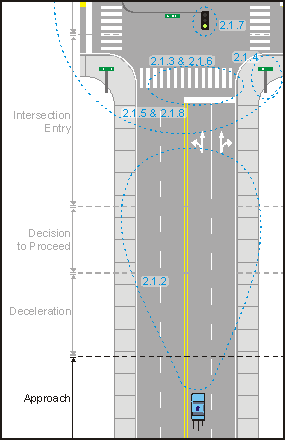
Blue dotted outlines indicate general distribution of primary information in key perceptual tasks.
Note: Illustration dimensions and vehicle positions are not to scale.
Figure 15. Scenario 2–Left Turn on Yellow Light Approach segment scenario diagram.
|
Table 21. Scenario 2–Left Turn on Yellow Light Approach segment relative timing and duration of segment tasks and summary of key findings.
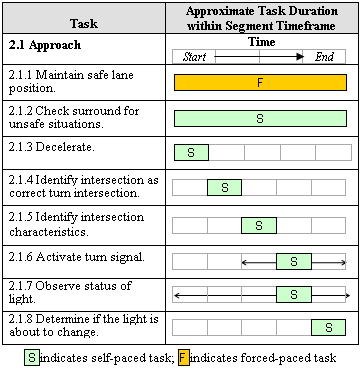
Potential contributions to high workload and information processing bottlenecks:
- Frequent perceptual tasks involving scanning or reading in 2.1.2, 2.1.5, and 2.1.8.
- Frequent cognitive tasks involving evaluation or judgment of multiple factors in 2.1.3, 2.1.5, and 2.1.8.
Mitigating factors:
- Most of the tasks are self-paced.
- Many tasks are routine, automatic activities.
|
Task Pacing and Timing - Task 2.1.1 (lane maintenance) is forced-paced because it is part of the ongoing task of driving.
The task ordering in this segment is different from the Approach segment from Scenario 1 because task 2.1.4 (identify intersection as the correct turn intersection) occurs early in the segment rather than late. There are two reasons for this difference. First, because the intersection is familiar, drivers are likely to recognize it quite far away. Second, in the present segment there is no requirement to read the street sign before identifying it (which removes the time constraints). The other tasks were ordered based on logical sequence-note that the sequence has no effect on combined or average workload levels because the tasks are sequential. Finally, tasks 2.1.6 (activate turn signal) and 2.1.7 (observe status of light) can occur over a range of time.
Scenario 2, Segment 2, Deceleration
The Deceleration segment involves the interval from when the subject vehicle begins decelerating and continues until the light turns yellow. The tasks, information processing subtasks, and workload estimates associated with this segment are shown in table 22. The scenario diagram, relative timing of tasks, and potential contributions to information processing bottlenecks and mitigating factors are shown in figure 16 and table 23.
Table 22. Scenario 2–Left Turn on Yellow Light Deceleration segment
tasks and information processing subtasks.
|
Task
|
Perceptual Subtasks
|
Cognitive Subtasks
|
Psychomotor Subtasks
|
|
2.2.1 Maintain safe lane position.
|
Visually monitor roadway ahead.
|
1
|
Verify correct lane position.
|
1
|
Make necessary adjustments to steering.
|
1
|
|
2.2.2. Check surround for unsafe situations.
|
Scan for potential obstacles/hazards.
Listen for indications of unsafe situations.
|
7
|
Determine whether perceptual input indicates if current situation is safe/unsafe.
|
4
|
Head and eye movements for scanning.
|
1
|
|
2.2.3 Begin deceleration.
|
Visually assess distance to intersection.
|
4
|
Determine when vehicle is close enough to intersection to begin deceleration.
|
6
|
Coast (foot off accelerator) and/or initiate braking.
|
3
|
|
2.2.4 Observe vehicle deceleration trajectory.
|
Visually assess distance to intersection.
|
4
|
Determine that deceleration is sufficient for slowing to turning speed at the intersection.
|
6
|
Make necessary adjustments to deceleration rate.
|
3
|
|
2.2.5 Maintain safe distance from decelerating following vehicle.
|
Visually assess distance and relative speed of following vehicle.
|
4
|
Determine if following vehicle closing trajectory is safe.*
|
5
|
Reduce deceleration if necessary.
Head and eye movements to observe rearview mirror.
|
3
|
* Difficulty in this subtask is increased by value of 1 because of degraded information.
Note that the objective of decelerating in this segment is to slow to turning speed before entering the intersection, rather than slowing to a stop as in Scenario 1. Note also that the task 2.2.5 (maintain safe distance from decelerating following vehicle) cognitive element was treated as involving the evaluation of a single dimension (workload estimate = 4), rather than as the evaluation of multiple dimensions (workload estimate = 6) based on relative speed and distance. The reason for this lower workload estimate is that evidence suggests that drivers may evaluate time-to-arrival as a single integrated variable (tau) rather than as separate speed and distance components.(11) Also, the estimated workload value for the cognitive element of this task was incremented by a value of 1 because determining the closing trajectory of the following vehicle is more difficult to accomplish using the degraded indirect visual information available from the rearview mirror. Note that this task is further complicated because the following vehicle's speed is also changing; however, the difficulty level was incremented only once to reflect these factors.
|
Scenario 2, Segment 2 Diagram
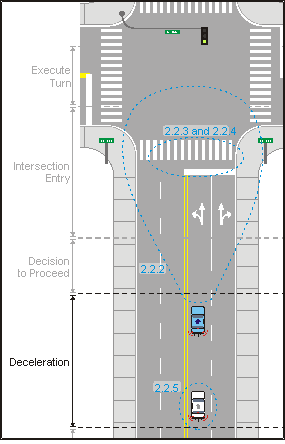
Blue dotted outlines indicate general distribution of primary information in key perceptual tasks.
Note: Illustration dimensions and vehicle positions are not to scale.
Figure 16. Scenario 2–Left Turn on Yellow Light Deceleration segment scenario diagram.
|
Table 23. Scenario 2–Left Turn on Yellow Light Deceleration segment relative timing and duration of segment tasks and summary of key findings.
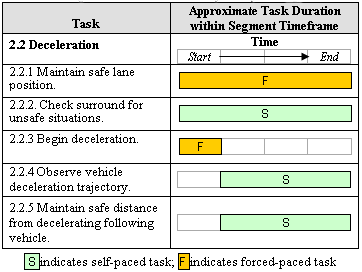
Potential contributions to high workload and information processing bottlenecks:
- Concurrent and continuous conduct of 2.2.1, 2.2.2, 2.2.4, and 2.2.5.
- Several demanding cognitive tasks involving either evaluation or judgment of multiple simultaneous factors (2.2.3 and 2.2.4) or a single factor under increased difficulty (2.2.5).
Mitigating factors:
- Most of the difficult tasks are self-paced.
- Most tasks are routine, automatic activities.
|
Task Pacing and Timing - Task 2.2.1 (lane maintenance) is forced-paced because it is part of the ongoing task of driving. Also, task 2.2.3 (begin decelerating) is forced-paced because the subject driver has a limited amount of time to decide to decelerate before the vehicle is too close to the stop line to permit safe or comfortable deceleration.
Regarding the task ordering, task 2.2.3 must come first because it initiates deceleration (the segment driving objective), whereas the other tasks are essentially ongoing throughout the segment.
Scenario 2, Segment 3, Decision to Proceed
The Decision to Proceed segment spans from the time when the traffic signal turns yellow to when the driver decides to proceed, which should occur quickly thereafter. The tasks, information processing subtasks, and workload estimates associated with this segment are shown in table 24. The scenario diagram, relative timing of tasks, and potential contributions to information processing bottlenecks and mitigating factors are shown in figure 17 and table 25.
Table 24. Scenario 2–Left Turn on Yellow Light Decision to Proceed segment
tasks and information processing subtasks.
|
Task
|
Perceptual Subtasks
|
Cognitive Subtasks
|
Psychomotor Subtasks
|
|
2.3.1 Maintain safe lane position.
|
Visually observe roadway ahead.
|
1
|
Verify correct lane position.
|
1
|
Make necessary adjustments to steering.
|
1
|
|
2.3.2 Check surround for unsafe situations.
|
Scan for potential obstacles/hazards.
Listen for indications of unsafe situations.
|
7
|
Determine whether perceptual input indicates if current situation is safe/unsafe.
|
4
|
Head and eye movements for scanning.
|
1
|
|
2.3.3 Observe vehicle deceleration trajectory.
|
Visually assess distance to intersection.
|
4
|
Determine that deceleration is sufficient for slowing to turning speed at the intersection.
|
6
|
Make necessary adjustments to deceleration rate.
|
3
|
|
2.3.4 Maintain safe distance from decelerating following vehicle.
|
Visually assess distance and relative speed of following vehicle.
|
4
|
Determine if following vehicle closing trajectory is safe.*
|
5
|
Reduce deceleration if necessary.
Head and eye movements to observe rearview mirror.
|
3
|
|
2.3.5 Observe status of light.
|
Visually observe traffic signal.
|
2
|
Identify color/status of traffic light.
|
2
|
Head and eye movements to view traffic signal.
|
1
|
|
2.3.6 Determine if stopping will conflict with following vehicle.
|
Visually assess trajectory of following vehicle.
|
4
|
Determine if following vehicle is too close or moving too fast to stop safely.*
|
5
|
Head and eye movements to view rearview mirror.
|
1
|
|
2.3.7 Determine if stop can be made before intersection.
|
Visually assess distance to the intersection.
|
4
|
Based on current speed, determine if it is possible to stop safely.
|
6
|
Head and eye movements to view intersection.
|
1
|
* Difficulty in this subtask is increased by value of 1 because of degraded information.
Because the onset of the yellow light occurs while the vehicle is still decelerating, tasks 2.3.3 (observe vehicle deceleration trajectory) and 2.3.4 (maintain safe distance from following vehicle) are carried over from the previous segment. Also, the estimated workload values for tasks 2.3.4 and 2.3.6 (determine if stopping will conflict with following vehicles) cognitive elements were incremented by a value of 1 because judging the trajectory of the following vehicle is more difficult to do using the degraded indirect visual information from the rearview mirror.
Another point is that although according to McKnight and Adams,(9) the subject vehicle should generally check for oncoming vehicles crossing the intersection before deciding to go, this task was not included in this decision segment because the subject vehicle can stop and wait before turning after oncoming traffic has passed. Oncoming traffic is instead dealt with in the next segment (the Intersection Entry segment). Finally, there is no separate task defined for the actual decision about whether to proceed. This decision process is the culmination of tasks 2.3.6 and 2.3.7, and the assumption is that the decision is an implicit result of resolving these tasks.
|
Scenario 2, Segment 3 Diagram
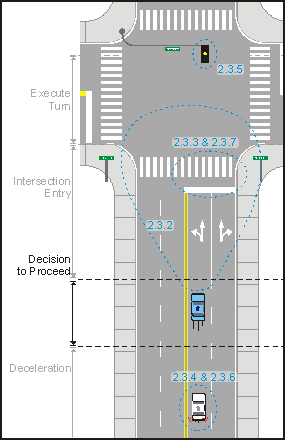
Blue dotted outlines indicate general distribution of primary information in key perceptual tasks.
Note: Illustration dimensions and vehicle positions are not to scale.
Figure 17. Scenario 2–Left Turn on Yellow Light Decision to Proceed segment scenario diagram.
|
Table 25. Scenario 2–Left Turn on Yellow Light Decision to Proceed segment relative timing and duration of segment tasks and summary of key findings.
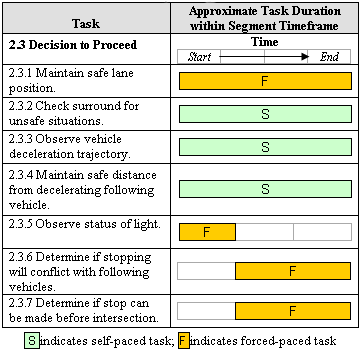
Potential contributions to high workload and information processing bottlenecks:
- Concurrent and continuous conduct of 2.3.1, 2.3.2, 2.3.3, 2.3.4, 2.3.6, and 2.3.7 in the latter part of the segment.
- Several demanding cognitive tasks involving either evaluation or judgment of a single factor (2.3.4 and 2.3.6) under difficult conditions or multiple simultaneous factors (2.3.3 and 2.3.7).
- Key tasks must be conducted with high time pressure.
Mitigating factors:
|
Task Pacing and Timing - Task 2.3.1 (lane maintenance) is forced-paced because it is part of the ongoing task of driving. Tasks 2.3.6 (determine if stopping will conflict with following vehicles) and 2.3.7 (determine if vehicle can stop) are forced-paced because they have to be completed as soon as possible following the onset of the yellow light in case it is necessary to stop (although that is not the case in the present scenario).
Regarding the task ordering, task 2.3.5 (observe light) must occur before tasks 2.3.6 and 2.3.7 because the former task initiates these latter tasks. Also, tasks 2.3.6 and 2.3.7 were depicted as occurring simultaneously when in fact they must be performed in a sequential manner. This was done because these tasks must be performed in a short time span, which may result in interference between the tasks. The other tasks are ongoing throughout the segment.
The Intersection Entry segment spans the time from just after the driver decides to proceed to when the subject vehicle gets into position in the intersection to make the turn. The tasks, information processing subtasks, and workload estimates associated with this segment are shown in table 26. The scenario diagram, relative timing of tasks, and potential contributions to information processing bottlenecks and mitigating factors are shown in figure 18 and table 27.
Table 26. Scenario 2–Left Turn on Yellow Light Intersection Entry segment
tasks and information processing subtasks.
|
Task
|
Perceptual Subtasks
|
Cognitive Subtasks
|
Psychomotor Subtasks
|
|
2.4.1 Maintain safe lane position.
|
Visually observe roadway ahead.
|
1
|
Verify correct lane position.
|
1
|
Make necessary adjustments to steering.
|
1
|
|
2.4.2 Check surround for unsafe situations.
|
Scan for potential obstacles/hazards.
Listen for indications of unsafe situations.
|
7
|
Determine whether perceptual input indicates if current situation is safe/unsafe.
|
4
|
Head and eye movements for scanning.
|
1
|
|
2.4.3 Decelerate to turning speed.
|
Visually assess distance to intersection.
|
4
|
Determine that deceleration is sufficient for slowing to turning speed or stopping in intersection.
|
6
|
Coast (foot off accelerator) and/or continue gentle braking.
|
3
|
|
2.4.4 Check for conflict with following vehicle.
|
Visually assess trajectory of following vehicles.
|
4
|
Determine if distance and speed of following vehicle indicate potential conflict.*
|
5
|
Head and eye movements to observe rearview mirror.
|
1
|
|
2.4.5 Check for red-light-running cross traffic.
|
Visually observe vehicles in left and right cross lanes.
|
5
|
Determine if crossing vehicles are stopped or will stop in time.
|
4
|
Head and eye movements for observing cross traffic.
|
1
|
|
2.4.6 Confirm that oncoming vehicles are stopping.
|
Visually observe oncoming traffic.
|
4
|
Determine that oncoming vehicle speed is decreasing fast enough to indicate stopping. Look for signals from drivers that they will not stop (flashing headlights).
|
4
|
Head and eye movements to view oncoming traffic.
|
1
|
|
2.4.7 Check for hazards in turn path.
|
Visually scan turn path to the left (especially crosswalk).
|
7
|
Determine if any pedestrians/cyclists or other hazards are in the crosswalk or about to enter.
|
4
|
Head and eye movements to view left-turn path.
|
1
|
|
2.4.8 Continue into intersection.
|
Visually observe intersection.
|
1
|
Determine when vehicle is in appropriate position for turning.
|
4
|
Accelerate and/or decelerate as needed.
|
3
|
*Difficulty in this subtask is increased by a value of 1 because of degraded information.
In this segment, tasks 2.4.3 (decelerate to turning speed) and 2.4.8 (continue into intersection) are similar in that they both involve maneuvering for the turn. The difference between them is that task 2.4.3 involves general speed control as the subject vehicle approaches the intersection for turning or stopping, whereas task 2.4.8 involves more fine-tuning of position and speed in preparation for executing the turn. Also, one assumption in this segment is that cross traffic is moving and in the process of slowing to a stop, which makes task 2.4.4 more difficult because it requires the subject driver to determine if the slowing vehicles are stopping rather than simply checking whether the vehicles are stopped at the intersection. Note also that this task may be unnecessary if the following vehicle decides to stop at the light; however, if the following vehicle also tries to make it through the yellow light, the following vehicle could approach more aggressively, thus increasing the potential for a conflict. Finally, the estimated workload value for the task 2.4.4 cognitive subtask was incremented by a value of 1, because determining the trajectory of the following vehicle is more difficult to do using degraded indirect visual information from the rearview mirror.
|
Scenario 2, Segment 4 Diagram
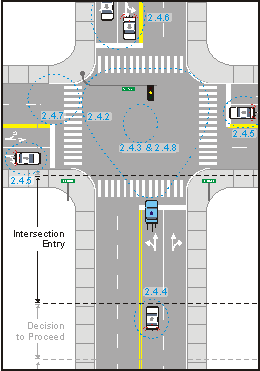
Blue dotted outlines indicate general distribution of primary information in key perceptual tasks.
Note: Illustration dimensions and vehicle positions are not to scale.
Figure 18. Scenario 2–Left Turn on Yellow Light Intersection Entry segment scenario diagram.
|
Table 27. Scenario 2–Left Turn on Yellow Light Intersection Entry segment relative timing and duration of segment tasks and summary of key findings.
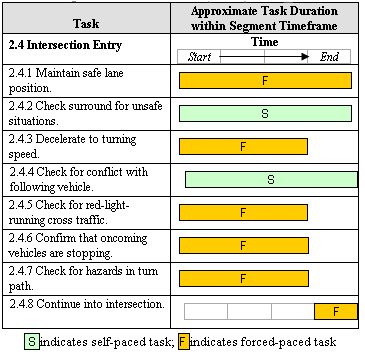
Potential contributions to high workload and information processing bottlenecks:
- Concurrent and continuous conduct of 2.4.1 through 2.4.4.
- Concurrent and forced-paced conduct of 2.4.5 through 2.4.7.
- Demanding perceptual tasks involving visual scanning (2.4.2 and 2.4.7) or monitoring traffic (2.4.5).
- Information sources are widely distributed.
- High number of tasks overall.
- High time pressure.
Mitigating factors:
|
Task Pacing and Timing - Tasks 2.4.1 (lane maintenance), 2.4.3 (decelerate to turning speed), and 2.4.8 (continue into intersection) are forced-paced because they are part of the ongoing task of driving. Task 2.4.5 (check for red-light-running traffic) is forced-paced because the subject driver needs to identify a potential conflict while there is still enough time to take evasive action. Similarly, tasks 2.4.6 (confirm that oncoming vehicles are stopping) and 2.4.7 (check for hazards in turn path) are forced-paced because drivers must evaluate these hazards while they still have sufficient time to stop in the intersection to let the hazards pass before turning.
Regarding the task ordering, tasks 2.4.3 and 2.4.8 were allocated based on where the vehicle is in relation to the turn location. Tasks 2.4.5, 2.4.6, and 2.4.7 were depicted as occurring simultaneously when they are more likely to be performed in a sequential manner because they draw on the same visual and cognitive resources. These tasks were shown as simultaneous because given the yellow onset time, the subject driver is likely to have less than 1 sec to perform these tasks by the time the previous segments are completed, which may result in interference between the tasks, or in some tasks being skipped altogether. The other tasks are ongoing throughout the segment.
Scenario 2, Segment 5, Execute Turn
The Execute Turn segment involves the actions related to initiating and completing the left turn. In this scenario, the subject vehicle can safely turn without first coming to a complete stop. The tasks, information processing subtasks, and workload estimates associated with this segment are shown in table 28. The scenario diagram, relative timing of tasks, and potential contributions to information processing bottlenecks and mitigating factors are shown in figure 19 and table 29.
Table 28. Scenario 2–Left Turn on Yellow Light Execute Turn Segment
tasks and information processing subtasks.
|
Task
|
Perceptual Subtasks
|
Cognitive Subtasks
|
Psychomotor Subtasks
|
|
2.5.1 Accelerate to initiate turn.
|
View roadway ahead.
|
3
|
Determine that acceleration is sufficient to get vehicle through the intersection in a timely manner.
|
4
|
Accelerate at necessary rate.
Head and eye movements to view roadway.
|
3
|
|
2.5.2 Steer into turn.
|
View turn path.
|
3
|
Determine that vehicle trajectory and lane position are appropriate.
|
6
|
Steer to the left and make necessary adjustments to stay in lane.
|
3
|
|
2.5.3 Check for hazards in turn path.
|
Visually scan turn path to the left (especially crosswalk).
|
7
|
Determine whether any pedestrians/cyclists or other hazards are in the crosswalk or about to enter.
|
4
|
Head and eye movements to view left-turn path.
|
1
|
|
2.5.4 Continue accelerating up to speed.
|
Visually observe roadway.
|
3
|
Determine when traveling speed is reached.
|
2
|
Accelerate at necessary rate.
Head and eye movements for viewing.
|
3
|
|
2.5.5 Maintain safe lane position.
|
Visually observe roadway ahead.
|
1
|
Verify correct lane position.
|
1
|
Make necessary adjustments to steering.
|
1
|
|
2.5.6 Check surround for unsafe situations.
|
Scan for potential obstacles/hazards.
Listen for indications of unsafe situations.
|
7
|
Determine whether perceptual input indicates if current situation is safe/unsafe.
|
4
|
Head and eye movements for scanning.
|
1
|
Note that task 2.5.1 (accelerate to initiate turn) has the same purpose as task 1.5.1 (accelerate to initiate turn) from Scenario 1, but it has different perceptual and cognitive subtask workload values. The reason is that in Scenario 1, oncoming vehicles are still approaching and present a possible danger that must be monitored; however, in the present scenario the subject driver is assumed to have already confirmed that oncoming vehicles are stopping. Also, task 2.5.4 (continue accelerating up to speed) is simply a continuation of task 2.5.1 in the new lane. Task 2.5.4 logically could have been eliminated by extending the duration of task 2.5.1; however, this task was retained to make this segment consistent with the other scenarios.
|
Scenario 2, Segment 5 Diagram
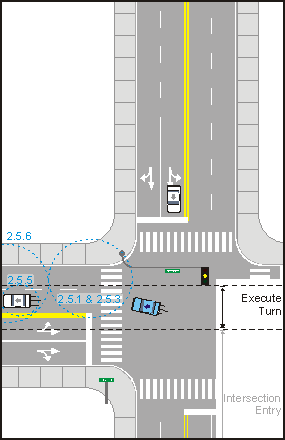
Blue dotted outlines indicate general distribution of primary information in key perceptual tasks.
Note: Illustration dimensions and vehicle positions are not to scale.
Figure 19. Scenario 2–Left Turn on Yellow Light Execute Turn segment scenario diagram.
|
Table 29. Scenario 2–Left Turn on Yellow Light Execute Turn segment relative timing and duration of segment tasks and summary
of key findings.
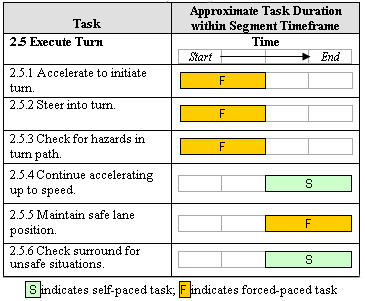
Potential contributions to high workload and information processing bottlenecks:
- Concurrent and continuous conduct of 2.5.1, 2.5.2, and 2.5.3, involve some high cognitvie (2.5.2) and perceptual (2.5.3, 2.5.6) workload.
Mitigating factors:
- Several tasks are routine, automatic activities
|
Task Pacing and Timing – The tasks associated with accelerating and making the left turn (tasks 2.5.1, 2.5.2, and 2.5.3) are forced-paced because they must be accomplished during the brief time that the vehicle is turning. Also, task 2.5.5 (lane maintenance) is forced-paced because it is part of the ongoing task of driving.
Regarding the task ordering, tasks 2.51 through 2.5.3 are concurrent, as are tasks 2.5.4 through 2.5.6.
Scenario-Wide Analysis
To help identify potential information processing bottlenecks in this scenario, workload estimates from all segments were combined into a single scenario-wide workload profile that provides a general indication of where the areas of high workload demands are likely to be.
Figure 20 shows the summed workload estimates (separately for each information processing subtask) in each segment interval for the entire scenario. Also, the intervals in which key tasks are forced-paced are shaded in orange. As indicated in figure 20, the workload levels are highest for both the perceptual and cognitive elements during the Decision to Proceed and Intersection Entry segments.
Figure 21, which displays the average workload estimate of all the tasks in play during a particular segment interval, shows that the peaks during the Decision to Proceed and Intersection Entry segments in figure 20 arise from several tasks combined rather than just a few difficult tasks. This is because the average workload values in this segment are not much greater than in the other segments, although the tasks are generally high in terms of workload level. Figure 21 indicates that peaks for cognitive subtasks occur in the Decision to Proceed and Execute Turn segments, whereas the peaks for the perceptual subtasks occur during the Approach and Intersection Entry segments.
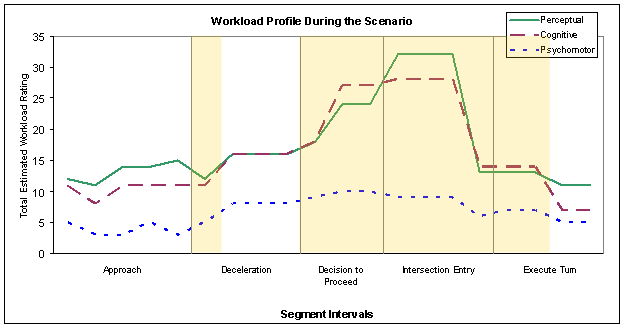
Note: Intervals containing nonroutine forced-paced tasks are shaded in orange. This graph shows the overall level of workload associated with a segment.
Figure 20. Scenario 2–Left Turn on Yellow Light total estimated workload ratings
for all tasks in each scenario segment.
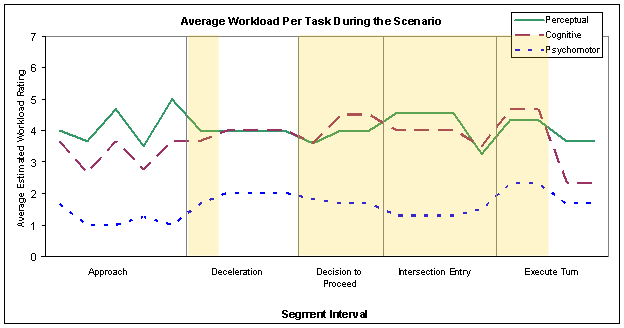
Note: Intervals containing nonroutine forced-paced tasks are shaded in orange. This graph generally represents the overall level of difficulty associated with the tasks in a segment.
Figure 21. Scenario 2–Left Turn on Yellow Light average estimated workload ratings
per task for each scenario segment.
Information Processing Bottlenecks
Information about the combined and average workload ratings, pacing of key tasks, and nature of bottlenecks for each segment is shown in table 30. Only information that represents potential problems is listed; blank cells indicate that no substantive issues occurred for a particular segment or cell. Following the table is a list of key information processing bottlenecks identified in each segment.
Table 30. Scenario 2–Left Turn on Yellow Light combined and average workload ratings, pacing of key tasks, and the nature of bottlenecks that indicate potential problems for each scenario segment.
|
Segment
|
Combined
Workload
|
Average
Workload
|
Pacing of Key Tasks
|
Nature of Bottlenecks
|
|
Approach
|
|
High perceptual workload.
|
|
Frequent perceptual tasks involving scanning or reading, and frequent cognitive tasks involving judging multiple factors.
|
|
Deceleration
|
Moderate perceptual and cognitive workload.
|
|
Some forced-paced tasks.
|
Concurrent and continuous conduct of several demanding cognitive tasks.
|
|
Decision to Proceed
|
High perceptual and cognitive workload.
|
High cognitive workload.
|
Forced-pacing of some key tasks.
|
Concurrent and continuous conduct of a high number of tasks, including several demanding cognitive tasks under time pressure.
|
|
Intersection Entry
|
High perceptual and cognitive workload.
|
High perceptual and cognitive workload.
|
Forced-pacing of several key tasks.
|
Concurrent and continuous conduct of a high number of tasks, including several perceptual and cognitive tasks with high workload, distributed information sources, and high time pressure.
|
|
Execute Turn
|
Moderate perceptual and cognitive workload.
|
High cognitive workload.
|
Forced-pacing of some key tasks.
|
Concurrent and continuous conduct of several tasks.
|
Approach nature of bottleneck: Visual demands:
- A high average perceptual subtask workload involves some overlapping of visual scanning and reading tasks; however, this situation is offset by self-pacing of most of these tasks.
Decision to Proceed nature of bottleneck: High time pressure:
- A high number of demanding tasks are concurrent, and key tasks in the latter part of the segment need to be conducted under high time pressure.
Intersection Entry nature of bottleneck: High time pressure for several tasks:
- A high number of demanding tasks are concurrent and draw on information distributed throughout the visual scene. In addition, a relatively high number of those tasks must also be performed under high time pressure.
Execute Turn nature of bottleneck: Concurrent tasks:
- Concurrent, demanding cognitive subtasks take place during the initial part of the segment; however, this situation is mitigated somewhat because most of these are routine, automatic driving tasks.
Previous | Table of Contents | Next
|
